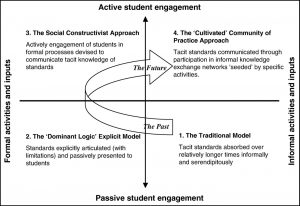“Assessment dialogues can help students to clarify ‘the rules of the game’, the assumptions known to lecturers but less transparent to students” (Carless 2006: 24).
What is it?
This is not an assessment itself but a means of fostering the skills of self-evaluation and clarifying standards of performance so students can close the gap between desired and current performance (Nicol and McFarlane Dick, 2006). Sadler (2010) states that ‘telling’ students standards through feedback comments, or just providing them with criteria on a VLE is not sufficient to help them fully conceptualise strong or weak performance.
Students are given examples of past assignments, exam questions, coursework, presentations, videos of performance etc, and then apply the assignment criteria to the exemplars. The resulting discussion then facilitates understanding of criteria in a concrete way, using examples to clarify students’ understanding of more abstract concepts such as critical thinking and analysis.
 Note: exemplars and ‘model answers’ are not the same thing and should be used in a different way. Model answers are more contentious as they are thought to facilitate surface learning through emulation and even encourage plagiarism, although in some disciplines where a fixed answer is required they are used uncontroversially.
Note: exemplars and ‘model answers’ are not the same thing and should be used in a different way. Model answers are more contentious as they are thought to facilitate surface learning through emulation and even encourage plagiarism, although in some disciplines where a fixed answer is required they are used uncontroversially.
Why would I use it?
There are many benefits of using exemplars:
- They help students to become assessment and feedback literate by having a clearer idea of what is required from the assignment, the learning outcomes associated with it, and the language used in criteria. Longer term, using exemplars can help to clarify for students the norms and conventions of the discipline, particularly in terms of discourses used.
- Exemplar activities can clarify assignment briefs and reduce anxiety in students.
- They shift students’ focus away from the grade by breaking down standards of performance into criteria.
- Trust in the teacher and in the marking process increases when it is seen as more transparent and dialogic.
Known issues:
- Exemplar activities can be seen by students and teachers as a way of assessing students’ accuracy in using the criteria to correctly estimate the grade given. They should be discouraged from doing this in initial stages, as part of the purpose is to shift students’ focus from the grade. However, you can add an element of fun and competition into the activity by having them write their estimated grade on the board and compare with the class before you ‘reveal’ the grade.
- You have to consider the ethics of using past papers and coursework and especially presentations. Ideally, you would be able to gain the student authors’ consent. If not, then you should go to strict lengths to anonymise (almost impossible in video) and ensure that students do not take the exemplars home.
- Some students can be initially frustrated with the potential subjectivity of marking with criteria and patience is needed while they develop more tolerance of ambiguity.
How has it been used?
Two useful resources are provided here which explain how to implement strategies for using exemplars and avoiding some common pitfalls:

Leave a Reply